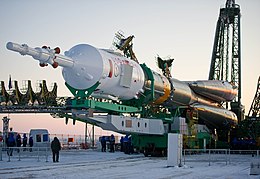 TMA-03M rollout in Baikonur | |
| Operator | Roscosmos |
|---|---|
| COSPAR ID | 2011-078A |
| SATCAT no. | 38036 |
| Spacecraft properties | |
| Spacecraft type | Soyuz-TMA 11F747 |
| Manufacturer | Energia |
| Crew | |
| Crew size | 3 |
| Members | Oleg Kononenko André Kuipers Donald Pettit |
| Callsign | Antares |
| Start of mission | |
| Launch date | 21 December 2011, 13:16 UTC[1][2][3] |
| Rocket | Soyuz-FG |
| Launch site | Baikonur 1/5 |
| End of mission | |
| Landing date | 1 July 2012, 08:14 UTC |
| Landing site | 146 km SE of Dzhezkazgan, Kazakhstan 47°20′56.3″N 69°32′47.4″E / 47.348972°N 69.546500°E[4] |
| Orbital parameters | |
| Reference system | Geocentric |
| Regime | Low Earth |
| Docking with ISS | |
| Docking port | Rassvet nadir |
| Docking date | 23 December 2011 15:19 UTC |
| Undocking date | 1 July 2012 04:47 UTC |
| Time docked | 190d 13h 28m |
 From left to right: Donald Pettit, Oleg Kononenko and André Kuipers Soyuz programme (Crewed missions) | |
Soyuz TMA-03M was a spaceflight to the International Space Station (ISS). It launched on 21 December 2011 from Site One at the Baikonur Cosmodrome, Kazakhstan, carrying three members of Expedition 30 to the ISS. TMA-03M was the 112th flight of a Russian Soyuz spacecraft, since the first in 1967, and the third flight of the modernised Soyuz-TMA-M version. The docking with the International Space Station took place at 19:19 Moscow Time on 23 December, three minutes ahead of schedule.[5][6]
The crew were Oleg Kononenko (Russia, commander), André Kuipers (the Netherlands) and Donald Pettit (United States). The Soyuz remained aboard the space station for the Expedition 30 increment to serve as an emergency escape vehicle if needed.
The capsule used in the mission can be seen at the Space Expo visitors center at the European Space Research and Technology Centre in Noordwijk, Netherlands.[7]
- ^ NASA. "Consolidated Launch Manifest". NASA. Retrieved 6 June 2011.
- ^ ESA astronaut André Kuipers to spend six months on the ISS starting in 2011
- ^ "Russian Rocket Launches Astronauts on Holiday Space Station Trip". Space.com. 21 December 2011. Archived from the original on 12 June 2023.
- ^ "Soyuz Landing Coordinates". NASA Spacflight Fourum. 2 July 2012. Retrieved 2 June 2018.
- ^ "ESA astronaut André Kuipers arrives at the Space Station". European Space Agency. 23 December 2011. Retrieved 24 December 2011.
- ^ Состоялся запуск транспортного пилотируемого корабля «Союз ТМА-03М» Archived 19 June 2013 at the Wayback Machine Roscosmos (in Russian)
- ^ "Exposition - All about space". Space Expo. Retrieved 24 May 2019.